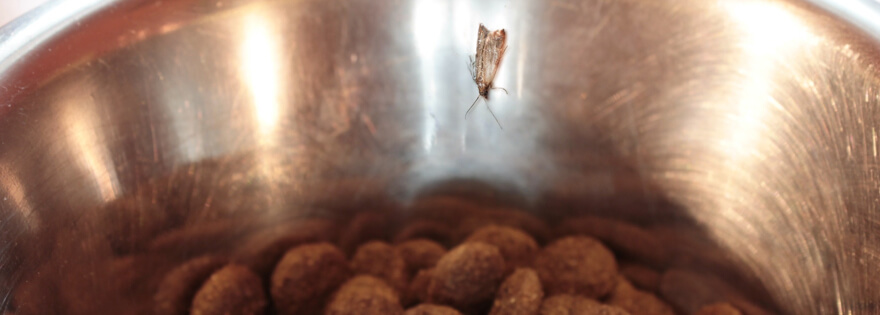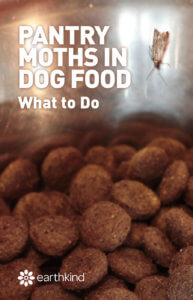Pantry Moths in Dog Food & Other Pet Food – What to Do
By: Lisa Dingeman
The moths that you find in pet food, such as dry dog food and cat kibble, are typically Indian meal moths. Moths and other bugs can find their way into your home through pet food products and other dry goods as well, such as in dried fruit, rice, beans, grains, and even cake mixes. They are usually already inside of the food packages themselves when they are brought into your home.
A bag of dog food or box of pet food most likely became contaminated with moths while it was at the factory or warehouse. Spoilage, which can lead to pests, can also happen while food packages sit on a shelf in an infested environment such as a storage facility or during transportation.
We go over why moths are attracted to pet food and what to do if you find them in your pet’s food.
Why They Are Attracted to Pet Food
Pantry moths are attracted to dog food and other dry pet food, such as birdseed, because their eggs can be hidden easily. As soon as the moth eggs hatch into larvae, their feeding stage, the scavengers are right where they need to be – close to a food source.
Detecting an infestation in a bag filled with pet food may be difficult, as the moths are likely to still be in their early egg stage, which means they will be harder to spot. During the egg stage, they will only measure about 1-2 hundredths of an inch. After hatching from the eggs, the moth larvae will measure up to ½ an inch and will look like a white worm or maggot with a brown head. If you are not inspecting the food, which most of us aren’t, you will not recognize a moth problem until you spot an adult flying around.
Once you see an adult moth, it has already gone through a large portion of its life cycle. It’s gone from egg to larvae, and pupa to adult—with a female adult having the ability to lay up to 400 eggs within 2 weeks. Clearly, detecting or preventing a problem is important because these pantry pests can reproduce so rapidly!
What to Do About Moths in Dog Food
If there are clear signs that moths have been inhabiting your dog or cat food (or any other family pet), the food should be sealed up, thrown away, and a new bag should be purchased. Sealing up the package before disposal will help ensure that other food items will not be contaminated as well.
If there are other foods, pet or human, nearby or in contact with the moth infested food, be sure to check them thoroughly. This is because the adult female moths continually sniff out the perfect place to lay their 400+ eggs. If you see similar signs, unfortunately, it’s best to throw out those items as well. If they show no signs of any critters, we recommend freezing the food for a week to kill any remaining eggs, just to be safe.
There’s no need for pet owners to panic if their dog eats food containing moths at any stage of their development. The good news is that pantry moths are not known to carry any diseases that will harm you or your pet.
Although they are not a significant health risk, these flying bugs are still unsightly. If the thought of serving your furry friend infested food sends shivers down your spine, take the time to check for a moth presence when purchasing new food:
- Sift through the first 4 inches of the food and carefully inspect it. They rarely go any deeper than 4 inches from the surface.
- Look for tiny white eggs, worm-like insects, casings, and white webbing–like that of a spider web. The webbing is formed when the cocoon is spun. Once hatched, you will notice the empty moth casings.
Prevent and Get Rid of Moths in Pet Food with These Natural Solutions
Once you get the food to your home and check it, it’s important to prevent moths and other pantry pests from infesting the food while it sits in your house or garage. Follow these tips to help:
- To prevent moths from inhabiting your pet’s food, dump the entire bag into an airtight glass or plastic container after thoroughly inspecting it. Any other moths nearby will not be able to sniff out or gain access to the food and will move along.
- Keep any other dry food that is in the area in a sealed container or a freezer, if it’s freezer-friendly.
- Promptly recycle or remove any boxes or food packaging that it came in because moth eggs may be hidden under the seams or inside the corrugate of cardboard boxes.
- Clean up your food storage area where traces of pet food may be present. Vacuum and wipe away any crumbs in the surrounding area. Doing so will eliminate any attractants that may lure them into the space.
- In addition to cleaning, place a pouch or two of EarthKind®’s Stay Away® Moths wherever pet food is stored. Two pouches per room is recommended for the most effective prevention. The pouches work by using a blend of essential oils that smell offensive to moths, but pleasant to humans. The scent obscures the food aromas and other odors that they seek out when looking for a safe place to lay eggs. Avoiding chemicals is the key goal when dealing with your loved ones and fur babies. Chemicals are not necessary and should be kept far away from your four-legged family.
If you come across an issue with these pests, it’s best to act quickly. Find the culprit, remove that food from your home quickly, inspect the surrounding area, and then clean every crevice and corner in the space. For more information and control methods on pantry moths, click here.









